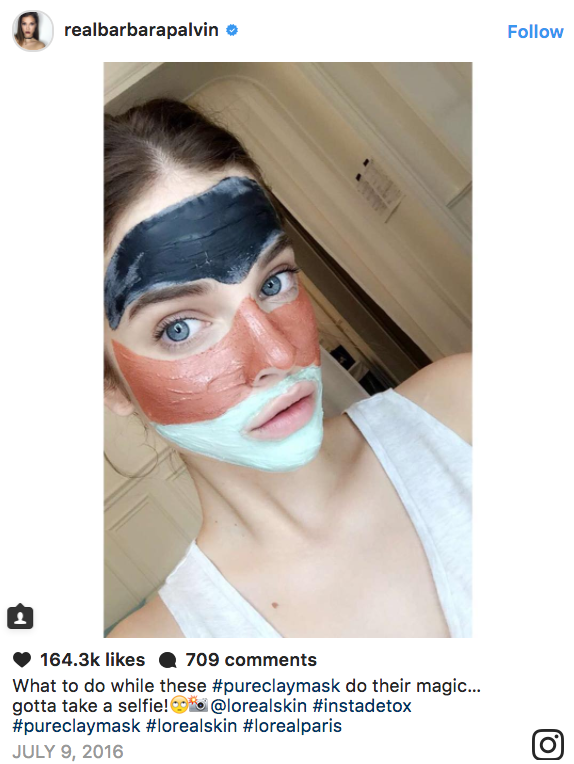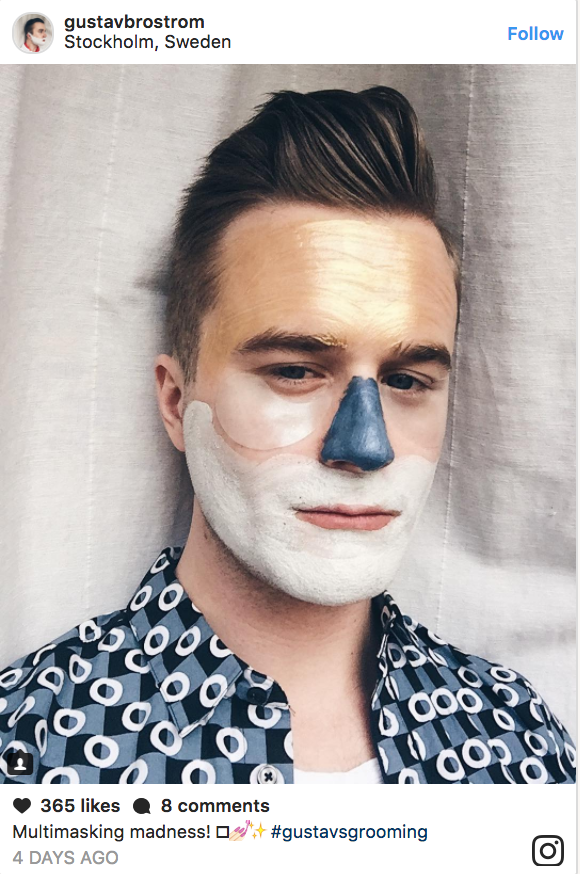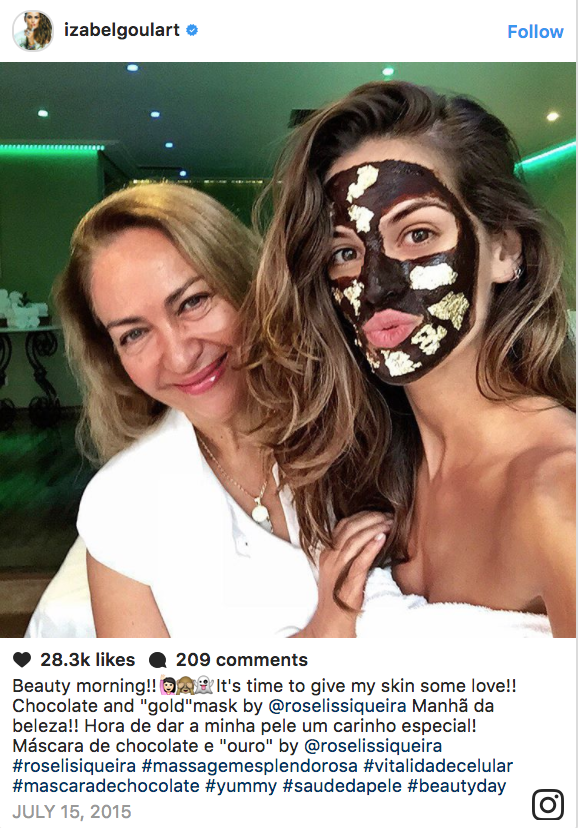How to Multi-Mask for Great Skin, According to the Experts
By Amber Kallor. Photos: Courtesy of Instagram.
At one point in time, using a mask meant either flooding dry skin with moisture or eking out every last ounce of acne-causing oil. It was a fairly straightforward choice with essentially two paths to follow. To say that the options have increased over the past few years might be the understatement of the century — the category has exploded, with “masking” becoming the most Googled beauty trend to date in 2017. With so many formulas — line-smoothing, cheek-lifting, deep-cleansing, you name it — how do you choose the right one for you? According to The Body Shop’s resident skincare expert, Vanda Serrador (also a famed facialist who tends to the temperamental complexions of celebs), you shouldn’t. “One mask can’t heal all,” she says. “Different areas of your skin have very different requirements. For example, your under-eyes may be dry, your cheeks blemish-prone, and your nose oily.” Instead of taking a one-and-done approach, try multi-masking: “It’s the perfect opportunity to treat different spots with different needs at the same time, and allows you to take it to the next level by creating bespoke, tailor-made treatments,” adds Serrador. Here, exactly how to get in on the selfie-friendly skincare trend:
1. Make sure to mask post-shower
A freshly washed face before masking goes without saying, but the optimal time to apply multiple formulas is after showering. “The steam helps loosen any debris that are clogging pores,” says New York City-based dermatologist, Dendy Engelman. “If you have dry skin, you can also use a mask to trap and retain moisture.”
2. Exfoliate first, or forget about it
Even if your complexion is parched and flaky, don’t be so quick to reach for the most moisturizing formula you can find. “Some people think their skin is really dry, so they layer on thick hydrating masks when they should, in fact, be using an exfoliating mask to remove dead cells first,” says Engelman. The jawline and brow area are both spots many patients tend to skip, but definitely deserve a good sloughing. Try The Body Shop Chinese Ginseng and Rice Clarifying Polishing Mask (which uses ginseng to stimulate circulation and sesame seed oil to soften), or Elizabeth Arden Visible Difference Peel and Reveal Revitalizing Mask that eliminates dead skin cells with glycolic acid. If you prefer to take a more manual approach, reach for a Clarisonic, Foreo, or nubby washcloth (that's totally clean, of course). Then, apply an essence or thermal water all over to restore hydration and gently pat your complexion dry before slathering on creams or clays, adds Serrador.
3. Microneedling may be the secret to success
If you want to take things up a notch and further enhance the penetration of ingredients, consider microneedling before you mask. The ultra-thin needles on an at-home dermaroller like the Beauty Bioscience GloPRO MicroStimulation Facial Tool produce little more than a light pinching sensation (similar to a “mini massage ball,” explains Engelman), but they do create undetectable “micro-channels” that help topical ingredients, like skin-plumping hyaluronic acid found in Caudalíe’s Moisturizing Mask, penetrate your complexion. “It’s like drilling little holes in the skin in order to enhance absorption,” says Engelman of the .3-millimeter long needles (in-office treatments employ needles that are .5 to 2 millimeters in length and require a topical numbing cream) that boast the added benefit of boosting collagen production. Then, apply your mask within 60 seconds. While the “ideal” candidate for microneedling is “prone to texture irregularity” like acne scarring or rouge patches, even sensitive types can get in on the action — simply apply less pressure and roll for a shorter period of time, adds Engelman. The only people who aren’t eligible are those with open wounds or active breakouts, as microneedling can spread bacteria and lead to infection.
4. Tailor your treatment
Each area of your face is its own special snowflake and craves individual time and attention. (Bonus: The more masks you use, the better the selfie.) “Instead of sticking to a rigid regimen, it’s best to assess your skin in the morning and evening to see what type of mask(s) you might need most,” says Engelman. “For example, if you were wearing really thick makeup during the day, you may need a clarifying mask followed by a calming mask. Alternately, if you know you’re about to get our period, you may want to look for a mask with anti-inflammatory properties.” For the latter case, she recommends finding a formula that contains salicylic acid, which offers a “quick fix” for hormonal breakouts. For a ready-made arsenal, try a sampler kit (like the ones from Peter Thomas Roth or Boscia) that comes complete with multiple masks.
5. Be strategic when slathering
Sit back, relax, and multi-mask — but don’t forget to read each formula’s instructions and map out a plan first. “Apply longer duration masks first and shorter contact ones later,” advises Illinois-based dermatologist Rebecca Tung. For more precision (and a prettier spread!) use a foundation brush with synthetic bristles, or reach for a tool with an angled tip (like The Body Shop’s angled Facial Mask Brush) to hit hard-to-reach spots like the crevices around your nose.
6. Go ahead and layer
“I don't like doing masks in sequence, but rather layering them one on top of the other,” explains New York City dermatologist Kavita Mariwalla. “The occlusion helps the masks penetrate.” Her personal multi-masking plan for normal to oily skin: “I put an enzyme mask on my T-zone, a rose hip mask on my marionette lines [also known as nasolabial folds], a phytocorrective mask on my cheeks, and then a charcoal jelly mask over the whole thing and chill for 15 minutes.” To recreate this regimen, try [The Body Shop’s British Rose Fresh Plumping Mask](https://www.thebodyshop.com/en-us/skin-care/face-masks/british-rose-fresh-plumping-mask/p/p002006) with rosehip oil sourced from Chile, Peter Thomas Roth’s Pumpkin Enzyme Mask, SkinCeuticals’ Phyto Corrective Masque, and top it all off with Universal Companies’ Prosana Collagen Charcoal Mask (Mariwalla’s must-have).
7. Remember to moisturize
After you’ve masked (and diligently documented it for the 'gram), rinse off any residue and give your face a good rubdown. “Massage helps increase blood circulation and absorption,” says Engelman. For a temporary lifting and tightening effect, try Clarisonic’s new Smart Profile Uplift Firming Massage Head. Finish with a light layer of lotion to seal in all the multi-masking benefits.
8. Don't overdo it
“As with everything, the biggest crime against your skin is overdoing it,” warns Engelman, who doesn’t recommend using more than two masks in the same place — employing any more ups your chances of irritation. “Over-masking can backfire, leading to irritated skin (dermatitis) and clogged pores (white heads).” In general, Mariwalla advises multi-masking once a week with up to four masks at a time, but frequency depends on how aggressive the formulas are and the overall sensitivity of your skin.
Multi-Masking Recommendations for Every Skin Type:
For Oil Slicks: Your T-zone (forehead, nose, and chin) tends to be the oiliest, so Engelman suggests looking for ingredients like clay, charcoal, or mud that “attract and bind to oil without drying out the skin.” Try L’Oréal Paris Purify and Mattify Pure-Clay Mask laced with eucalyptus, or The Body Shop’s Himalayan Charcoal Purifying Glow Mask infused with detoxifying bamboo charcoal from the Himalayan foothills.
For Parched Places: “The driest areas tend to be raised — like the apples of your cheeks and spots with thin skin, like the lips and around the eyes,” says Engelman. Tung likes formulas containing “lipid-rich agents such as safflower oil, mineral oil, glycerin, and hyaluronic acid.” Sensitive spots will enjoy the surge of moisture offered by both Avène’s Soothing Moisture Mask and SkinCeuticals Hydrating B5 Masque (two of Tung’s favorites).
For Dark Spots: If hyperpigmentation is your top concern, treat uneven skin tone (which often occurs on the cheeks, says Engelman) and lighten pigment with masks containing brightening vitamin C, algae, kojic acid, or licorice. Try Algenist Algae Brightening Mask infused with six different kinds of algae or Bliss Multi-Face-Eted All-In-One Anti-Aging Clay Mask featuring kojic and glycolic acid.
For Breakouts: Philosophy’s Purity Made Simple Pore Extractor Mask lessens the look of pores and battles blemishes via white clay and salicylic acid. Spot treat or swathe it over areas prone to pimples.
For Fine Lines: Plump wrinkles temporarily via formulas like Youth To the People Age Prevention Superfood Mask (containing antioxidant spirulina, kale, spinach, and green tea along with hyaluronic acid) or Dior Hydra Life Extra Plump Smooth Balm Mask rich in skin softening jojoba and shea butter. For the “Cinderella” effect, says Mariwalla, try SkinBetter Science InvisiLift Lifting Experience, which claims to tighten your complexion in three minutes for up to 12 hours. To target crow’s feet and the thin skin around eyes, add Shiseido’s Benefiance WrinkleResist24 Pure Retinol Express Smoothing Eye Mask — easy-to-apply patches — to your routine.
This story originally appeared on Allure.
More from Allure:
10 Celebrity Hairstyles That Make You Look 10 Years Younger
Find the Best Haircut for Your Face Shape
The 9 Prettiest Date-Night Makeup Looks
7 Weird Tricks Stars Use for Looking Great in Photos






